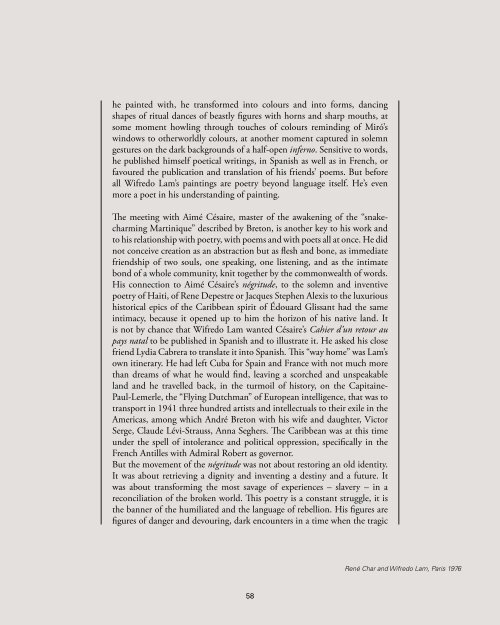Dominique de Villepin – The fraternity of sorcerers: Wifredo Lam and the poets
Excerpt from the book “Wifredo Lam – Nouveau Nouveau Monde”, a fully illustrated catalogue published in English on the occasion of the eponymous special exhibition.
Excerpt from the book “Wifredo Lam – Nouveau Nouveau Monde”, a fully illustrated catalogue published in English on the occasion of the eponymous special exhibition.
Create successful ePaper yourself
Turn your PDF publications into a flip-book with our unique Google optimized e-Paper software.
he painted with, he transformed into colours <strong>and</strong> into forms, dancing<br />
shapes <strong>of</strong> ritual dances <strong>of</strong> beastly figures with horns <strong>and</strong> sharp mouths, at<br />
some moment howling through touches <strong>of</strong> colours reminding <strong>of</strong> Miró’s<br />
windows to o<strong>the</strong>rworldly colours, at ano<strong>the</strong>r moment captured in solemn<br />
gestures on <strong>the</strong> dark backgrounds <strong>of</strong> a half-open inferno. Sensitive to words,<br />
he published himself poetical writings, in Spanish as well as in French, or<br />
favoured <strong>the</strong> publication <strong>and</strong> translation <strong>of</strong> his friends’ poems. But before<br />
all <strong>Wifredo</strong> <strong>Lam</strong>’s paintings are poetry beyond language itself. He’s even<br />
more a poet in his un<strong>de</strong>rst<strong>and</strong>ing <strong>of</strong> painting.<br />
The meeting with Aimé Césaire, master <strong>of</strong> <strong>the</strong> awakening <strong>of</strong> <strong>the</strong> “snakecharming<br />
Martinique” <strong>de</strong>scribed by Breton, is ano<strong>the</strong>r key to his work <strong>and</strong><br />
to his relationship with poetry, with poems <strong>and</strong> with <strong>poets</strong> all at once. He did<br />
not conceive creation as an abstraction but as flesh <strong>and</strong> bone, as immediate<br />
friendship <strong>of</strong> two souls, one speaking, one listening, <strong>and</strong> as <strong>the</strong> intimate<br />
bond <strong>of</strong> a whole community, knit toge<strong>the</strong>r by <strong>the</strong> commonwealth <strong>of</strong> words.<br />
His connection to Aimé Césaire’s négritu<strong>de</strong>, to <strong>the</strong> solemn <strong>and</strong> inventive<br />
poetry <strong>of</strong> Haiti, <strong>of</strong> Rene Depestre or Jacques Stephen Alexis to <strong>the</strong> luxurious<br />
historical epics <strong>of</strong> <strong>the</strong> Caribbean spirit <strong>of</strong> Édouard Glissant had <strong>the</strong> same<br />
intimacy, because it opened up to him <strong>the</strong> horizon <strong>of</strong> his native l<strong>and</strong>. It<br />
is not by chance that <strong>Wifredo</strong> <strong>Lam</strong> wanted Césaire’s Cahier d’un retour au<br />
pays natal to be published in Spanish <strong>and</strong> to illustrate it. He asked his close<br />
friend Lydia Cabrera to translate it into Spanish. This “way home” was <strong>Lam</strong>’s<br />
own itinerary. He had left Cuba for Spain <strong>and</strong> France with not much more<br />
than dreams <strong>of</strong> what he would find, leaving a scorched <strong>and</strong> unspeakable<br />
l<strong>and</strong> <strong>and</strong> he travelled back, in <strong>the</strong> turmoil <strong>of</strong> history, on <strong>the</strong> Capitaine-<br />
Paul-Lemerle, <strong>the</strong> “Flying Dutchman” <strong>of</strong> European intelligence, that was to<br />
transport in 1941 three hundred artists <strong>and</strong> intellectuals to <strong>the</strong>ir exile in <strong>the</strong><br />
Americas, among which André Breton with his wife <strong>and</strong> daughter, Victor<br />
Serge, Clau<strong>de</strong> Lévi-Strauss, Anna Seghers. The Caribbean was at this time<br />
un<strong>de</strong>r <strong>the</strong> spell <strong>of</strong> intolerance <strong>and</strong> political oppression, specifically in <strong>the</strong><br />
French Antilles with Admiral Robert as governor.<br />
But <strong>the</strong> movement <strong>of</strong> <strong>the</strong> négritu<strong>de</strong> was not about restoring an old i<strong>de</strong>ntity.<br />
It was about retrieving a dignity <strong>and</strong> inventing a <strong>de</strong>stiny <strong>and</strong> a future. It<br />
was about transforming <strong>the</strong> most savage <strong>of</strong> experiences – slavery – in a<br />
reconciliation <strong>of</strong> <strong>the</strong> broken world. This poetry is a constant struggle, it is<br />
<strong>the</strong> banner <strong>of</strong> <strong>the</strong> humiliated <strong>and</strong> <strong>the</strong> language <strong>of</strong> rebellion. His figures are<br />
figures <strong>of</strong> danger <strong>and</strong> <strong>de</strong>vouring, dark encounters in a time when <strong>the</strong> tragic<br />
René Char <strong>and</strong> <strong>Wifredo</strong> <strong>Lam</strong>, Paris 1976<br />
58

















